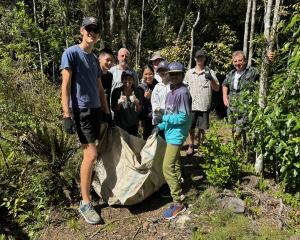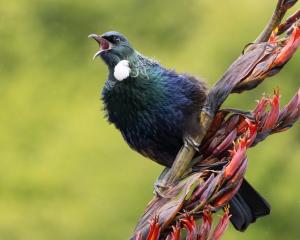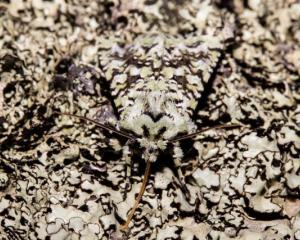Of the 24 or so bird species known to be residing in Orokonui Ecosanctuary, most were either living there before the predator fence was completed in 2007 or, like kaka, saddleback, robin, kiwi and takahe, they were released after the removal of predatory mammals inside the fence.
The first three translocated - kaka, saddleback and robin - are all capable of flying over the fence, where they face predation by a phalanx of feral animals.
Then there are those that have flown into the sanctuary from the scary wider world.
Surprisingly, few tui were reported in the Orokonui Valley podocarp and kanuka forest before the ecosanctuary came along. Now, though, tui are attracted to Orokonui's bird feeders and they are among the most conspicuous species. They jostle with each other and with the bellbirds and kaka for a turn at the sugar-water dispensers. Very young fledglings have been reported at the feeders.
If you are not familiar with these glossy, bossy bush birds, Orokonui is almost guaranteed to produce them for you so long as you are patient.
European settlers had an alternative name for the tui - parson bird - because they come smartly dressed up with a narrow collar of short, curly white feathers.
Even more surprising than the tui story is that of the fernbird or matata, found only in New Zealand and occupying a genus (Bowdleria) of its own. The South Island version is called Bowdleria punctata.
Although there are scattered fernbird populations in areas within view of Orokonui, including Swampy Summit and the Silver Peaks, only a few fernbirds inhabited the edges of Orokonui Valley along Blueskin Rd and around the prominent peak of Mopani before Orokonui's fence went up.
Eastern parts of Otago, the Waihola-Waipori wetlands and Catlins estuaries have good numbers, but few people encounter them. This is because they mainly flit about inside the canopy of shrubland and low forest or through vegetation in wetlands and estuarine areas.
They are rarely seen in tall forest.
Secretive birds, they are coloured a gingery chestnut brown with darker streaks and spots on a pale front - therefore, well camouflaged when perched inside shrubland. They fly in short, jerky bursts, trailing frayed tail feathers. Their typical call, a metallic "uu-tick", is often the only clue to their presence. Their diet is predominantly made up of invertebrates, especially caterpillars, beetles, flies and moths.
Protection of wetlands has helped stabilise their numbers in many places and now Orokonui's shrubland is attracting them.
Conservation manager Elton Smith reports fledglings inside the fence in sufficient number to indicate breeding success for several pairs.
Fernbirds can be heard or seen around the top end of the ecosanctuary, near the visitor centre location. One of the walkways is called the Fernbird Track/Te Ara a Matata, which starts about 100m from the entrance gate.
Rangers and volunteers have seen and heard a lot more fernbirds in this area than last year.
Spring is when they set territories, build nests and are most vocal. They nest low to the ground in rushes and tussocks, weaving beautifully sculptured cups of grass and sedge lined with feathers. They generally produce two to four eggs a clutch and can have up to three clutches a year in the right conditions.
Orokonui Ecosanctuary appears to be offering good food and breeding habitat, judging by the surge in numbers, and happily for visitors fernbirds are but a short walk from the main entrance.
Around the Fernbird Track you may strike a rare birding double - matata and takahe.
The two male takahe released into the ecosanctuary in May are mostly hidden in the bush in this area but they do come out to the grassed areas to feed on pellets.
• Neville Peat, co-author of Wild Dunedin, chairs the trust board of Orokonui Ecosanctuary.












